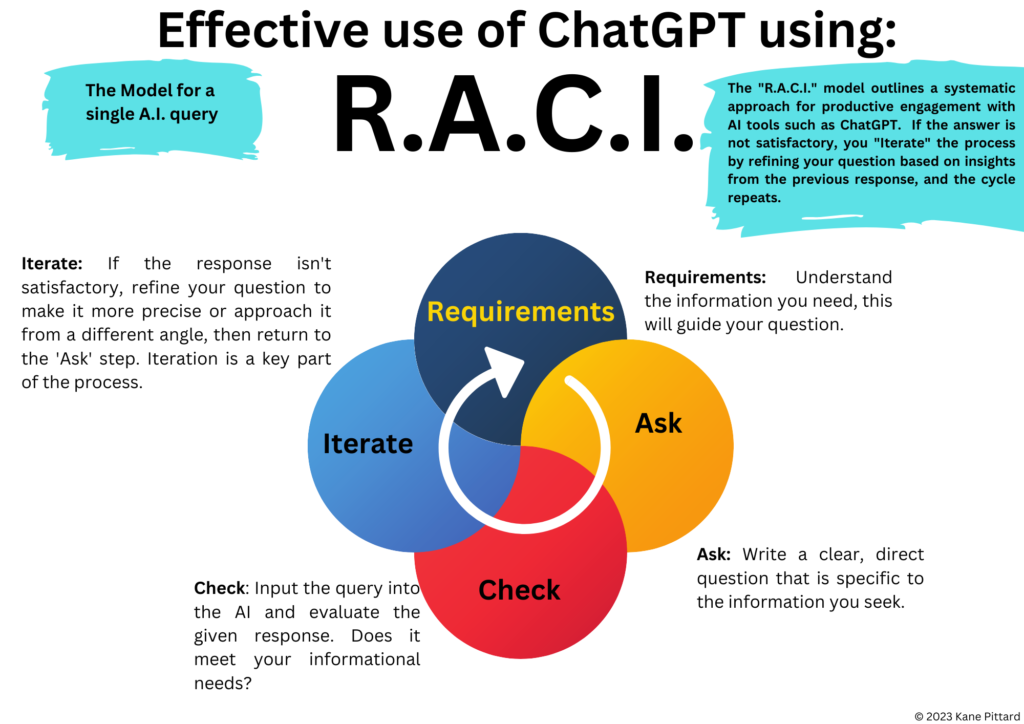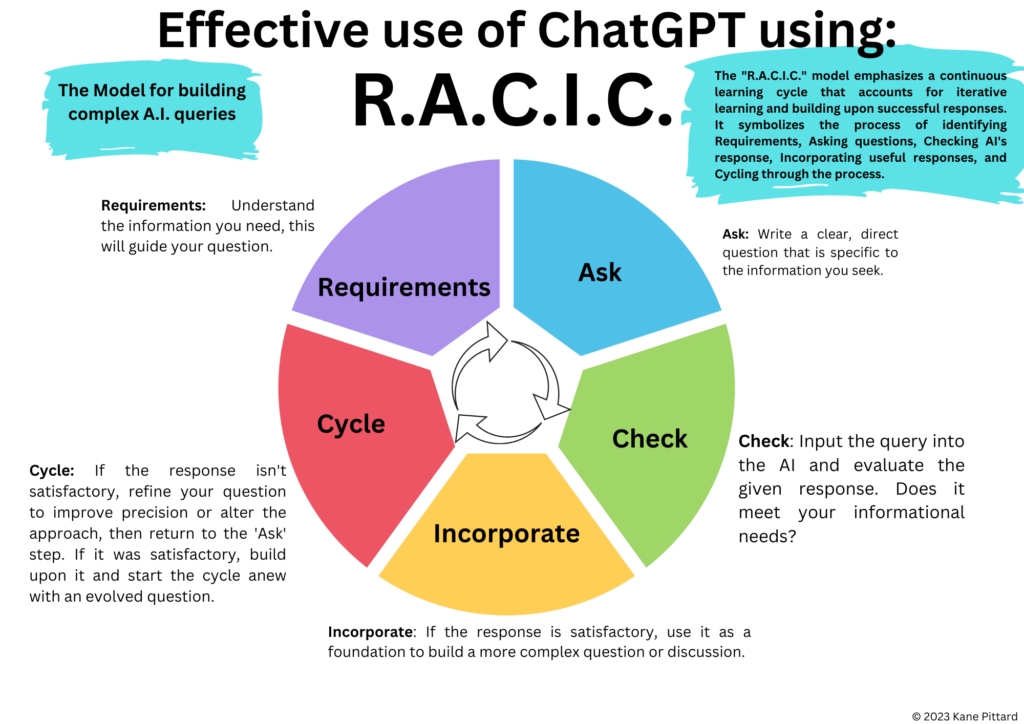With the advent of generative AI like ChatGPT, the landscape of education is evolving. ChatGPT, equipped with extensive data from various domains, can answer queries, assist in homework, generate essay drafts, and even provide content explanations. However, to harness these AIs effectively, a structured approach to constructing and refining queries and assessing responses is crucial.
What is missing from to assist educators is a clear and simple framework to work with. I am proposing the following two models are a simplified approach to assist educators and others in effectively using ChatGPT, Bard and other AI tools as they develop.
The two models are R.A.C.I. and R.A.C.I.C. models come into play.
Importantly for educators, content-rich subject knowledge is instrumental to effectively harness the potential of AI tools like ChatGPT in education. A solid understanding of the subject matter allows users to craft more targeted, nuanced questions that elicit comprehensive and in-depth responses from the AI. This not only promotes a more meaningful engagement with the AI but also ensures a more accurate evaluation of the AI’s responses. Furthermore, possessing a rich understanding of the content enables users to interpret the AI’s responses within a broader context, making connections, spotting inaccuracies, and expanding their inquiry based on the information provided. Therefore, the depth and breadth of subject knowledge plays a pivotal role in enhancing the efficiency and educational value of interactions with ChatGPT.
The R.A.C.I Model: Starting Point for Students

The R.A.C.I. (Requirements, Ask, Check, Iterate) model provides a solid starting point for students to engage with AI. This model ensures students can use AI to effectively find the information they need.
- Requirements: Determine the specific information needed.
- Ask: Formulate a clear, concise question aimed at obtaining the information.
- Check: Evaluate the AI’s response for accuracy and relevance.
- Iterate: If the response isn’t satisfactory, refine the question and begin the process anew.
For example:
| Requirements | Ask | Check | Iterate |
| Understand the concept of photosynthesis. | What is photosynthesis and why is it important? | Assess if the response provides a clear and correct explanation. | If the response is unclear or incorrect, rephrase the question or ask for more details. |
The R.I.C.I. model underscores the importance of good content knowledge in formulating effective queries. Understanding the topic allows students to craft more precise inquiries and critically evaluate AI’s responses.
Ket examine the model in a simple use case on a educator wanting to learn about the attack on Pearl Harbor.
Requirements: The teacher wants to explain the circumstances surrounding the attack on Pearl Harbor to their students.
Ask 1:“What is the historical background of the attack on Pearl Harbor?”
Check: The teacher reviews ChatGPT’s response for accuracy and relevance. If it aligns with known historical accounts and provides a clear overview, the response is considered satisfactory.
Incorporate (assuming the response was satisfactory): The teacher uses the AI’s response as a base to craft a more specific question.
Ask 2: “What were the key events leading up to the attack on Pearl Harbor?”
Check: The teacher evaluates the AI’s response, looking for details about diplomatic tensions, Japan’s imperial ambitions, the U.S.’s oil embargo against Japan, etc.
Iterate: If the response isn’t satisfactory, the teacher refines the question to get more precise information. For instance, they might ask, “How did the U.S. oil embargo against Japan lead to the attack on Pearl Harbor?”
This iterative process allows the teacher to delve deeper into the topic, guiding their students through a nuanced exploration of the events surrounding the attack on Pearl Harbor. The R.I.C.I. model ensures that each step is purposeful and each question is built upon a satisfactory response from the AI, paving the way for effective, AI-assisted teaching.
The R.A.C.I.C Model: A Comprehensive Approach for Teachers
While R.I.C.I. is an excellent starting point, teachers and advanced students can employ the R.A.C.I.C. (Requirements, Ask, Check, Incorporate, Cycle) model for more complex, iterative conversations.

- Requirements: Identify the information needed.
- Ask: Construct a clear, concise question.
- Check: Evaluate the AI’s response.
- Incorporate: If the response is satisfactory, use it as a base to build a more complex discussion.
- Cycle: If the response isn’t satisfactory, refine the question. If it is, build upon it and start the cycle anew with a more complex question.
For instance:
| Requirements | Ask | Check | Incorporate | Cycle |
| Learn about the French Revolution’s causes. | What were the main causes of the French Revolution? | Evaluate the response for accuracy and relevance. | Use the satisfactory response to ask a deeper question, such as: “How did the financial crisis contribute to the French Revolution?” | Build upon the responses iteratively to create a comprehensive understanding of the topic. |
The R.A.C.I.C. model promotes dynamic learning, incorporating AI’s responses into a continuous cycle of refined and complex inquiries.
let’s create a more complex use-case with the R.A.C.I.C. model, involving a teacher planning a differentiated lesson about the attack on Pearl Harbor:
Cycle 1
Requirements: The teacher wants to create a set of basic questions about the attack on Pearl Harbor for a worksheet.
Ask: “What are the fundamental facts about the attack on Pearl Harbor?”
Check: The teacher evaluates the AI’s response for accuracy and relevance. Assuming the response provides basic facts about the date, location, involved parties, and outcomes, the teacher deems it satisfactory.
Incorporate & Cycle: The teacher uses these facts to develop a set of questions for the worksheet, such as “When did the attack occur?”, “Who attacked Pearl Harbor?”, and “What were the immediate consequences?”
Cycle 2
Requirements: The teacher needs to differentiate the questions for three high school grade levels.
Ask: “What are the key aspects of the attack on Pearl Harbor suitable for 9th, 10th, and 11th graders?”
Check: The teacher evaluates the AI’s response, looking for a progression of complexity appropriate for each grade level.
Incorporate & Cycle: The teacher uses the AI’s response to adjust the worksheet questions, e.g., focusing on factual recall for 9th graders, the strategic significance of the attack for 10th graders, and the international implications for 11th graders.
Cycle 3
Requirements: The teacher wants to create a corresponding PowerPoint presentation.
Ask: “What key visuals and supporting information would be suitable for a PowerPoint presentation on the attack on Pearl Harbor?”
Check: The teacher evaluates the AI’s suggestions, looking for a combination of compelling visuals (maps, photographs, etc.) and supporting text that aligns with the differentiated questions.
Incorporate & Cycle: Based on the AI’s response, the teacher creates a 5-slide PowerPoint presentation, each slide addressing a different aspect of the attack, differentiated by grade level: basic facts for 9th graders, strategic considerations for 10th graders, and international implications for 11th graders.
The R.A.C.I.C. model has guided the teacher through the iterative process of developing a differentiated lesson plan, from formulating basic questions to creating an engaging, tiered presentation. The process illustrates how each cycle builds upon the product of the previous one, refining and improving the educational materials.
Evaluating the R.A.C.I.C Model
The strength of the R.A.C.I.C. model lies in its capacity for iterative learning, facilitating deeper, more nuanced conversations. It encourages users to build upon the AI’s responses, progressively improving their understanding of the subject matter.
One critique of the R.A.C.I.C. model might be its assumption that users can evaluate AI responses effectively. For instance, in the early stages of learning a topic, students might struggle to judge the relevance or accuracy of an AI response. However, this can be mitigated by fostering strong foundational knowledge before embarking on more complex discussions.
Both the R.I.C.I. and R.A.C.I.C. models provide excellent frameworks for students and educators to interact effectively with AI, such as ChatGPT, in an educational context. By structuring the question-asking and response-checking process, these models ensure that AI resources are used efficiently and to their full potential. They promote a cyclical, iterative approach to learning, fostering a deeper understanding of topics and more enriched classroom discussions. As AI continues to evolve and integrate more deeply into education, these frameworks will be invaluable tools to enhance teaching and learning outcomes.
